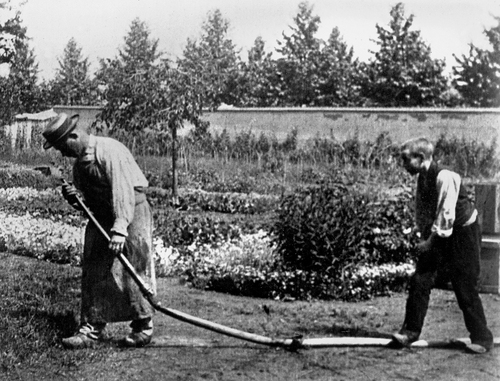However, with the advent of sound, the popularity of slapstick comedy declined and the genre underwent a significant transformation. Instead of relying exclusively on physical mishap and acrobatic stunts, comedic humor of the 1930s focused much more on witty dialogue, which was most notably displayed in the zany humor of the Marx Brothers. Moreover, with the Marx Brothers, comedy developed into a satirical tool for mocking the establishment through situations that were often absurd and risqué (e.g. their 1933 film, Duck Soup, which functioned as a political, anti-war satire piece). Nevertheless, with Laurel & Hardy and the Three Stooges rising to fame during the 1930s, the slapstick subgenre still managed to demonstrate its comedic worth to talkies.
The comedy genre continued to evolve throughout the course of the 1930s with the screwball comedy subgenre, which offered escapist entertainment for Depression-era audiences and was characterized by social satire that often took an anarchic tone or irreverent view of domestic or romantic conflicts. Frank Capra was the star director of this particular subgenre, and his film It Happened One Night (1934) provides a seminal example of the screwball comedy. German director Ernst Lubitsch also left his mark on comedy at the time by poking fun at the idle rich and embracing a sophisticated comedy style that was aptly named “The Lubitsch Touch (Dirks).” When the 1940s were ushered in, most comedy films embraced a more serious tone and focused on topics pertaining to politics, materialism, and the war, which were geared towards a more mature audience (e.g. Sturges’ satires The Lady Eve, released in 1940, and Sullivan’s Travel, released in 1941). With the 1950s, the comedy genre welcomed the comic duo of Dean Martin and Jerry Lewis (who starred in films such as 1955’s, You’re Never Too Young), but was largely characterized by an era of sanitized, formulaic, courtship romantic comedies, such as Pillow Talk (Gordon, 1959). This trend of comedies catering to a more mature audience continued throughout the 1960s, with Dr. Strangelove (Kubrick, 1964) using satire to address social change, and The Graduate (Nichols, 1967) acknowledging the sexual revolution.
In the 1970s and 1980s, the comedy genre really embraced satirical humor and parody, allowing directors like Woody Allen and Mel Brooks to thrive. Around this time, the British comedy troupe, Monty Python, also established themselves as significant contributors to the genre, embracing an over-the-top approach to humor similar to that of the Marx Brothers. The 1980s additionally saw a flood of teen comedies that included Fast Times at Ridgemont High (Heckerling, 1982) and Sixteen Candles (Hughes, 1984). As for the 1990s, during this period of time, actors created larger-than-life characters that relied on exaggerated speaking, movement, and expression, similar to slapstick comedy from the silent era. Of all the comedic actors from the 1990s, Mike Myers, Jim Carrey, and Adam Sandler particularly dominated the genre and became household names.
This ultimately led into the comedy genre’s latest trend of adopting a “no limits” approach to the bounds of propriety. Typically, comedy films from the 21st century are R-rated films that contain generous portions of profanity, sex, and debauchery. This inclusion of raunchier lines and content seems pretty alarming in regards to what society deems humorous, and really begs the question of whether or not the comedy genre can continue to be taken seriously. Although the comedy genre’s intended goal has always been to entertain viewers, the recently adopted gratuitous inclusion of shocking content makes me wonder how the comedy genre will continue to evolve (or devolve for that matter). Nevertheless, the history of the comedy genre remains a fascinating subject for discussion and given its longevity, should be recognized and appreciated as a significant aspect of film history.
Works Cited
Dirks, Tim, ed. "Comedy Films." Filmsite. <http://www.filmsite.org/comedyfilms.html>.


 RSS Feed
RSS Feed
